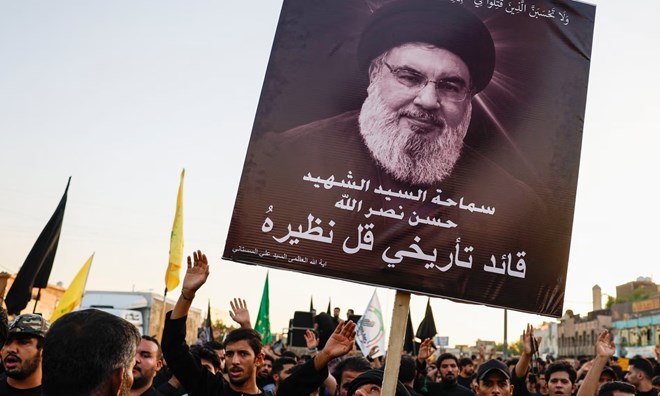
Monday September 30, 2024
By Dan Sabbagh
The success of Israel’s operation stands in sharp contrast to its misjudgment of Hamas’s intentions before 7 October

Mourners beneath a placard of Hassan Nasrallah, who was killed by an Israeli airstrike in Beirut, during a symbolic funeral in Baghdad, Iraq on Sunday. Photograph: Thaier Al-Sudani/Reuters
A hundred munitions – including, it is believed, US-made 2,000lb bombs – were used by the Israeli air force in Friday evening’s overwhelming air raid that killed the Hezbollah leader, Hassan Nasrallah, in an underground complex hidden in the southern Beirut suburb of Dahieh.
Nasrallah, who was careful to the point of paranoia about his security arrangements and only rarely appeared in public, would have given little notice of his plan to undertake the fateful trip to the meeting.
But the intelligence penetration of Hezbollah was so deep that Israel knew Nasrallah and other surviving members of Hezbollah’s already decimated leadership would be meeting at the supposedly secret location – and that an order to bomb them could be given.
Benjamin Netanyahu was required to give permission to undertake the attack from New York, where the Israeli prime minister had given a bellicose speech at the UN general assembly. There was, presumably, felt to be little time to wait.
According to an unsubstantiated report in the French newspaper Le Parisien, the mole who informed the Israelis that Nasrallah was on his way to the bunker was Iranian. If true, it would be eye-catching, given that Iran is Hezbollah’s principal backer.
The reports of the planning behind the attack indicate that Israel had an eye on the location for some time. The commander of the 69th Squadron of F-15I jets that carried out the attack, named in Israeli media only as Lt Col M, said the aircrews involved were preparing for “several days”, though they were told of the intended target only a few hours before. The F-15I jets were armed to strike and destroy below ground, requiring a large amount of explosive, capable also of eliminating the buildings above.
Video released by the Israel Defense Forces on Saturday of the jets “taking off for the strike from Hatzerim airbase” showed eight US-made F-15Is. One taking off is laden with multiple missiles, under the wings and at the rear. Experts said they appeared to be American-manufactured BLU-109 2,000lb bombs, of the class the Biden administration had decided to withhold from Israel in the summer amid concerns about their use in densely populated Gaza.
Justin Bronk, an aviation expert with the Royal United Services Institute (Rusi) thinktank, said the Israeli air force would have probably used 2,000lb joint direct attack munition guided missiles fitted with penetrating fuses designed to explode after a building or the ground is struck. Israeli air force officers said that during the attack, named Operation New Order, about 100 munitions were used and that bombs were dropped “every two seconds”.
Four residential buildings were hit, three destroyed utterly, leaving behind only smouldering craters, and two more were damaged in the strike. Initial estimates on the ground suggested that 300 people may have been killed, although Lebanon’s official count was that 11 were killed and 108 wounded. Israel said it had killed more than 20 members of Hezbollah and that the strike was justified because “Nasrallah intentionally built Hezbollah’s central headquarters under residential buildings in Dahiya”.
Brig Gen Amichai Levine, the commander of the Hatzerim airbase where the 69th Squadron is based, gave more details of the planning. The first challenge, in what he coldly described as “elimination operations” was precise intelligence; the second, he said at a briefing, was to ensure that the target “does not escape while the planes are en route or the munitions are on their way to the target” – for example by not receiving early warning that the fighter jets were in the air and on their way.
A tantalising question is why Nasrallah felt it necessary to meet other Hezbollah members in person. It was nearly a fortnight ago that Israel’s war against Hezbollah stepped up with the explosions of sabotaged pagers and walkie-talkies used by the militant group that may have injured as many as 1,500 – low tech preferred by Nasrallah because he distrusted the way mobile phones could be tracked. With all electronic means distrusted, a face-to-face meeting may have been the only way to discuss Israel’s escalation of the crisis with close colleagues.
In any event, it is now clear that Israel has been unfolding an orchestrated plan in the past fortnight to attack and destroy Hezbollah’s military leadership, from the pager attack to several rounds of airstrikes, wreaking havoc on Lebanese civilians as it does so. An estimated million people have been displaced as well as several hundred killed, a price Jerusalem deems acceptable as it seeks to halt Hezbollah attacks on Israel’s north and allow 65,000 Israelis to go back home from the border area.
Israel’s success in killing Nasrallah and other leaders can only have come following an intelligence penetration of Hezbollah that stands in sharp contrast to the misjudgment of Hamas’s intentions before 7 October. Matthew Savill, a military analyst at Rusi, said Israel probably “spent years building up and sustaining a comprehensive intelligence picture” of Hezbollah, involving “an element of human sources involved, to keep it current”.
That, he argued, “brings into even starker relief the failure to identify and prevent Hamas’s operation last year, lending credibility to the theory they concentrated on Lebanon and Iran at the expense of Gaza”.